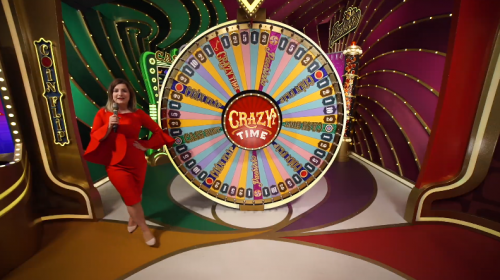Introduction
Crazy Time could be briefly described as an elaborate form of Big Six. It adds random multipliers and four slices represent independent games the player will play if the initiating spin stops in the slice for that game. The whole thing is played by live dealers about once a minute, 24 hours a day, 7 days a week, by the upbeat and energetic live dealers of Evolution Gaming.
According to Bitcasino.io, the return of the game is 96.08%.

Disclaimer
Evolution, the maker of Crazy Time, is very protective of their game rules and don’t disclose many details that one would need to do a proper math analysis of the game. Fortunatley, there is Tracksino, which tracks some statistics of the game. For elements of the game that can’t be quantified I used historical data from Tracksino and tweaked it a bit to get the return of all bets close to 96.08%. That said, I do not claim all of the following rules are exact, but they are my best guess.
Base Game Rules
Sit back and pay attention, as the Crazy Time rules are rather involved. If you get confused, maybe watching my video on how to play Crazy Time will help.
- The base game is played on a vertical wheel with 54 stops. The player may bet on where the wheel will stop. The table below shows the available bets and the number of stops of each on the wheel.
- After betting is closed, the “Top Slot” will spin. The left of two reels will stop first on one of the eight bets. Then the right wheel will usually stop on a multiplier. If the wheel stops on the same bet chosen by the Top Slot, then the win for that bet shall be multiplied by the multplier on the right reel. If the right reel stops between multipliers, then no prize will be multiplied. For example, the game might pick Pachinko and 5X. This would mean that if the outcome of the spin lands on Pachinko, then the win from the Pachinko game will be multiplied by 5.
- All wins are on a “to one” basis. Bets on 1, 2, 5, and 10 pay those same odds. For example, a winning bet on 5 will pay 5 to 1.
- If the wheel stops on Coin Flip, Pachinko, Cash Hunt, or Crazy Time, then that game will be played. Any bets on that slice be eligible to play the game and pay according to its outcome and any Top Slot multiplier earned.
- The rules of each bonus game are indicated below.
Following are the basic rules of each bonus. I get into much more detail on them in the analysis sections below.
- Cash Hunt: This is a simple bonus with 108 symbols with a win behind each one. The player may pick any symbol. At the end of the bonus the wins behind the symbols are revealed.
- Coin Flip: Two wins are randomly assigned to both sides of a coin. One side will have a win from 2 to 5 and the other from 7 to 100. The coin is flipped, determining the player’s win.
- Pachinko: This is played on a Plinko board with 16 possibles wins or multipliers on the bottom. If the puck lands in a multiplier, then all the fixed wins are doubled and the puck dropped again. Eventually, the puck will land in a fixed win, which is what winning Pachinko bets will pay.
- Crazy Time: This is both the name of the game itself as well as a particular bonus round. This bonus round is the most elaborate and takes the most time to play. It is played on a prize wheel with three stoppers, which the player may choose from. Where the prize wheel stops on the chosen stopper will be bonus win. There are also multipliers on the wheel, which will double or triple all fixed wins and the wheel will be re-spun.
Both the Pachinko and Crazy Time bonuses could, in theory, go on indefinitely with doubles and triples, resulting in enormous prizes. Although this rule will probably never have to be enforced, there is a maximum win of 20,000 for both games.
The following table shows the eight available bets on the Base Game wheel and the number of stops on each one.

